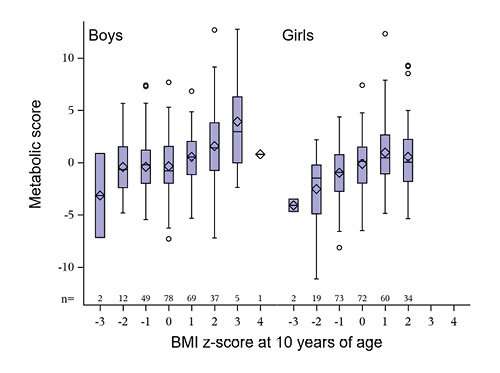Cardiovascular risk markers in 20-year-olds after high childhood BMI

Subjects having overweight and obesity at age 10 were found to have elevated risk markers for diabetes and cardiovascular disease by the time they reach the age of 20. A University of Gothenburg study shows the importance of early preventive and health-promoting measures.
The proportion with overweight or obesity in Sweden is 11% of 4-year-olds; in those aged 11–15, it is 15%. These proportions have more than doubled in less than 30 years. In young adults aged 16–29, the figure is as high as 31%, according to statistics from the Public Health Agency of Sweden.
The connection between children's early growth patterns and their state of health later in life is already well-known. Children and adolescents with overweight or obesity have an elevated risk for cardiovascular disease, disabling osteoarthritis, hormonal disorders, and diabetes as they grow older.
The current study, "Features of Childhood Growth, Lifestyle, and Environment Associated with a Cardiometabolic Risk Score in Young Adults," published in the journal Obesity Facts, provides results that further corroborate the link between BMI at a young age and later morbidity risk. The first author is Staffan Mårild, associate professor of pediatrics at Sahlgrenska Academy, University of Gothenburg, who is also a pediatrician.
Further key data from long-term follow-up
"We've analyzed a huge quantity of various growth-related data on children from 0 to 10 years of age. These data were retrieved from the routine health checks at maternity wards, child health centers, and Swedish school health-care services. We've in addition supplemented these data with questionnaire data, where for example parental heights and weights have also been reported," Mårild says.
Later on, a sample of 513 individuals aged 18–20 underwent a targeted health examination with follow-up growth data, blood samples, and a new questionnaire survey. A "cardiometabolic index" (CMI) was used for improved assessment of the risks of future diabetes and cardiovascular disease, and to rank the disease risks in each individual in the study.
"The CMI summarizes every individual's measures on lipids in blood, blood-sugar balance, blood pressure, and waist circumference. Our primary aim was to assess the connection between childhood overweight and obesity on the one hand, and the cardiometabolic index the young adults in the follow-up study on the other hand," Mårild says.
Measures to promote every child's health
The main result of the study is that study participants with overweight and obese at age 10 showed a significant increase in the cardiometabolic index, and thus an increased risk of disease later in life, compared with normal-weight 10-year-olds.
According to the researchers, the results highlight the immense importance of the school health services' health surveys, which include growth measurements and enable study of children in the risk zone. The importance of preventive and health-promoting initiatives at preschool, as well as in youth education and society at large, is emphasized. The cornerstones are a healthy diet, daily exercise and regular physical activity, reduced stress, and sufficient sleep.
"Initiatives should be directed not specifically or solely at children with overweight or obesity but at all children, regardless of their BMI, since these health promotion efforts are important for every child. Targeting only children with elevated BMI can be perceived as stigmatizing and should be avoided," Mårild says.
More information: Staffan Mårild et al, Features of childhood growth, lifestyle and environment associated with a cardiometabolic risk score in young adults, Obesity Facts (2021). DOI: 10.1159/000520661





















